1885 and 1895 Women Middle Class Summer Fashion
The Victorian era was almost a century of mode. In that time, ladies' Victorian hats grew from the large bonnet to the minor bonnet, short chapeau to alpine hat, plain to elaborately busy. Keeping rail of all the changes is no piece of cake feat, as chapeau styles came and went every few years. Changes mimicked dress fashions besides as hairstyles. At that place were hats for every occasion, from walking, riding, morningwear, and even home employ.
The following explores major changes in Victorian hat fashions from the pre-Victorian 1830s to the late 1890s. It is sourced from Victorian Costume and Costume Accessories past Anne Buck, published in 1961 (Copyright expired).
Virtually ladies' Victorian hats are not readily available, at least non at reasonable costs, in the early and mid-Victorian styles. Making your own Victorian hat is the best option using a hat design or a felt or straw base with which to decorate. Uncomplicated modern hats and bonnets in the right shape can be re-busy with flowers, bows, feathers, and ribbon to match the preferred decade and style.
Await here for modernistic Victorian inspired hats and bases to get yous started. For men'southward hats, look hither.
Victorian Bonnets 1830s -1850s
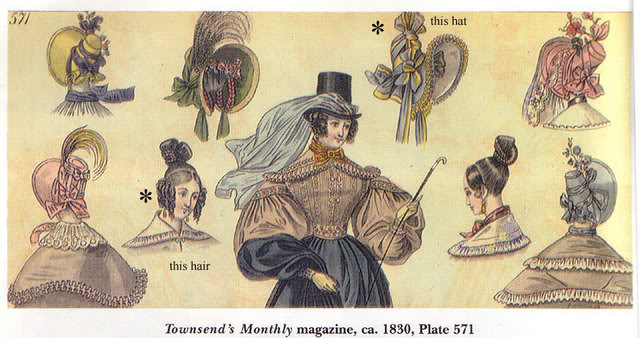
1830 hats
The bonnet which was worn in the twelvemonth of Queen Victoria'due south accession had a wide brim, non then large as it had been in the 1830s, but still making a wide spreading frame for the face. The crown, which was roughly the shape of a cone with the summit cutting off, was set at an bending to the brim. This was the shape for bonnets of straw and for those made of silk or velvet on a stiff foundation, simply there was some other method of making which gave a slightly dissimilar shaping.
The drawn bonnets, those in which the material was gathered over a framework of cane or wire, had the same shaping of the brim, but the framework gave a horseshoe shape to the puffed and gathered crown.
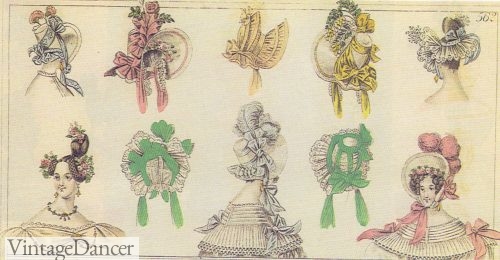
1830s Bonnets
The straw bonnets may be Leghorn bonnets, that is, of straw grown in Tuscany and plaited in the Italian manner. These were yet the almost fashionable of harbinger bonnets. They can be distinguished by the fineness of the straw, and by the method of plaiting, with each braid plaited into the next so that the fabric of the bonnet appears continuous.
Their English language rivals, rather less fashionable and expensive, were Dunstable bonnets of English harbinger, in which the larger English wheat-straw was divide before plaiting and the plaited braids were then sewn together. In some bonnets, the Leghorn straw was used, plaited and sewn in England in the English manner.
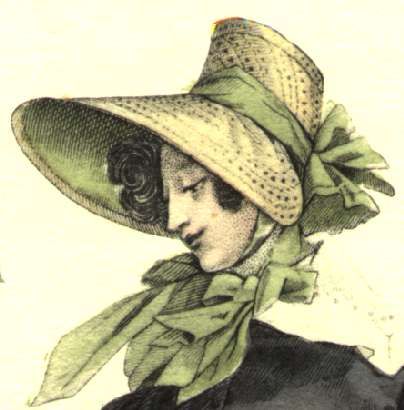
1830s harbinger bonnet
Straw bonnets were worn during the summer months. They were worn fashionably with walking dress, but amongst the less fashionable and in the land, they appeared on all occasions. These bonnets were most e'er plainly trimmed, with ribbons. The more fashionable dress bonnets were in silk of many different kinds, plainly silk or satin, watered silk, figured silk; and transparent bonnets in net, crepe or lace were regarded equally specially becoming. Velvet was the usual material for wintertime.
Ribbon and feathers were the well-nigh full general trimming; the bird of paradise plumage was the most fashionable for the years 1835 to 1845. Flowers were besides used. The trimming of the within of the skirt was as important as the trimming of the exterior of the bonnet, and lace, ribbon and flowers were used to decoration it. The lining of the bonnet brim was also of import.
"No ane article in the whole range of female costume is more important in its effects than that comparatively small piece of satin, silk or other material that forms the lining of the bonnet" (Mrs. M. J. Howell, Handbook of Millinery, 1847. Read it here).
Advertiser
Simply some straw bonnets appear to have been worn with unlined brims. The bonnets I by and large have wide ribbons to tie beneath the mentum, and a mantle— which in the harbinger bonnets may be of straw or ribbon—to shield the back of the neck. The curtain—or bavolet, for it is sometimes called past its French name—is plant in nearly all bonnets from the starting time of the period until the 1860s.
Straw bonnets of this early menstruation may be found now, either denuded of their original ribbons and feathers or with the added trimmings of "dressing upward", professional or amateur. The straw ones are more likely to have suffered alteration than the silk ones, where trimming and foundation can less easily exist separated, but any bonnet may, of course, take had flowers, ribbons and feathers removed from it or added to information technology.
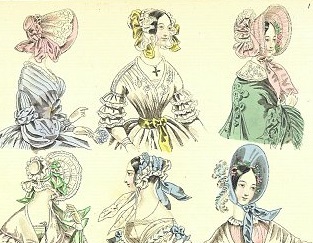
1838 hats
The modify in the shape of the bonnet began in 1838, when a form with brim and crown continuous in a straight line appeared. This was not a new course. Bonnets of this type, which had been known as the cottage bonnet, had been worn in the first decade of the century.
The shaping of the 1840s was distinguished from the before examples by the downwardly curve of the lower border from the back of the crown to the border of the brim, the brim coming down low on the cheek, covering the face. For the whole of the next decade, 1840 to 1850, this was the bonnet form
. The simply variation was in its close and open up styles, the former endmost in on the face up and the latter having a wider brim; but both, in profile, had the same horizontal line from brim to crown.
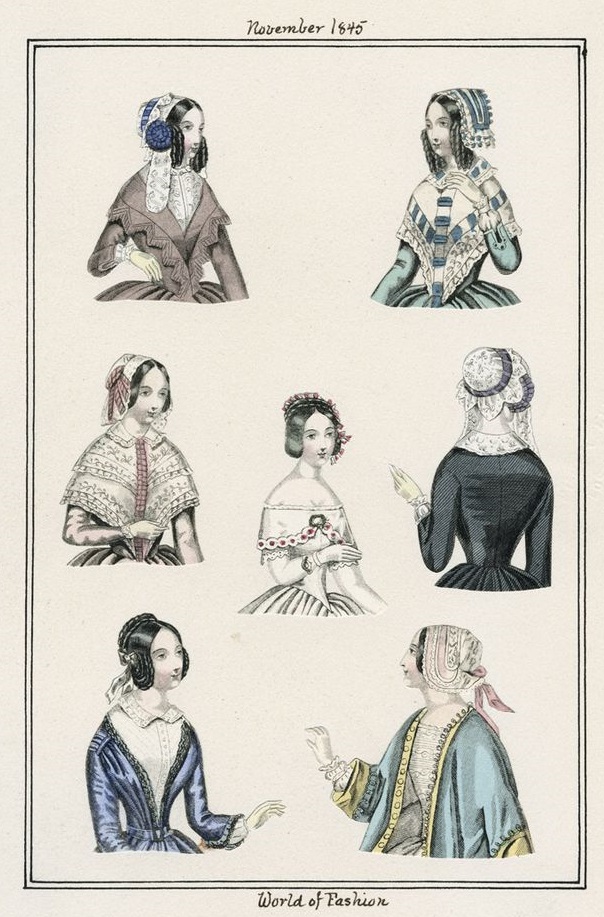
1845 drawn bonnets
The drawn-bonnet construction of the 1830s continued in this new class. Silk or satin was gathered over a serial of cane hoops, and the back of the crown was a stiffened circle. Other bonnets were made in silk and satin, laid tightly over a stiff foundation. Straw bonnets still continued to be worn for summer. Flake plait, which is made from fine wood splints, was likewise stylish. From the heart of the 1840s, openwork straw plaits, and fine straw mixed with horsehair in fancy braids, or alternating braids of straw and horsehair, were much used. Velvet remained the usual material for winter bonnets.
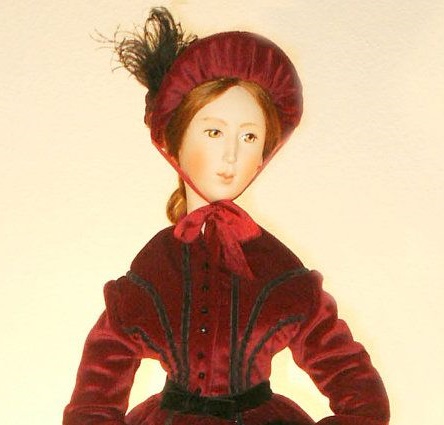
Velvet bonnet with plumage
The trimming was ribbon, a wreath of flowers or a single feather falling from the center down one side of the bonnet. At that place was even so trimming inside the skirt—a ruching of ribbon, net or lace, a wreath of flowers to frame the face, or knots of ribbon, cyberspace or lace, or flowers at each side.
By 1850 the open up form of bonnet was more full general than the shut, and from this came the change of bonnet shape in the 1850s. The brim opened more than widely around the face and the crown grew lower and smaller, so that by 1853 the new shaping was established: "information technology is the peculiar grade of crown which gives this appearance, by being made low and sloping towards the back" (World of Fashion, 1853). This bonnet was worn well dorsum on the caput, revealing the face, looking a niggling as if information technology were slipping off backwards.
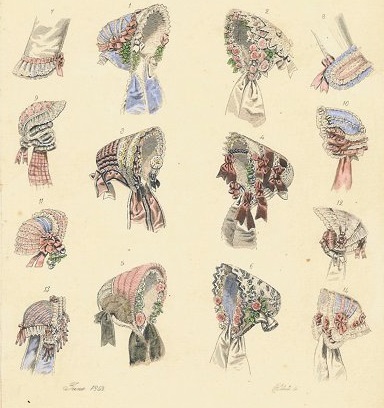
1853 bonnets
Bonnets of the last two years of the decade accept the sides curving dorsum, exposing yet more than of the face, only the top more forrad on the forehead. In the early on 1860s, the front rose high, narrow and rather pointed, with the sides receding, giving a shape which was aptly called spoon-shaped. Straw, horsehair, velvet, net and crepe were all fashionable for these bonnets, and they were trimmed with flowers, feathers, ribbon and lace. They usually had very long curtains in the belatedly 1850s and early 1860s.
"The bavolet has remained stationary. Had it increased in size, it would have get quite a tippet" (Ladies' Treasury, 1858).
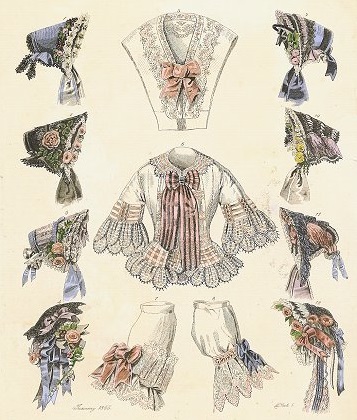
1855 bonnets
Early Victorian Hats – 1850s, 1860s
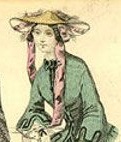
1850 circular top hat
At the start of the reign, hats were not fashionable, although by the tardily 1840s a large, round straw hat was being worn at the seaside, and for garden and country wear. These hats were unremarkably rather flat-crowned with broad, turned-down brims, made of coarse straw.
From 1857, hats became fashionable wear for younger women: "of course they are not suited to elderly ladies" (World of Mode, 1857). These as well were hats with rather flat crowns, but wide curving brims, a form unremarkably trimmed with ribbon and feathers placed at the front.
Hats were yet but used for the virtually informal wearable but, during the 1860s, hats of different shapes were gradually taking the place of bonnets —at least for the younger women—for all but the about formal occasions.
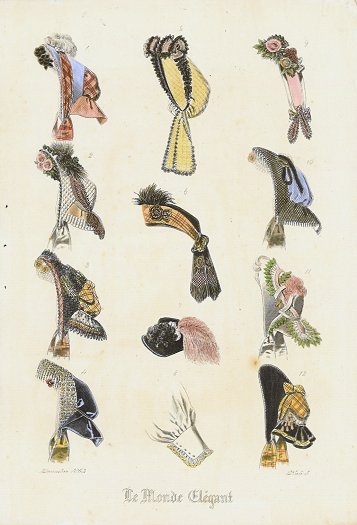
1863 hats and bonnets
In 1861, there were three main shapes: a hat with oval crown and brim turned up at the sides; a round chapeau with turned back brim; and a higher-crowned bell-shaped hat. A small sailor hat with round crown and straight narrow skirt joined these shapes in 1863. This, and the circular hat with the turned-back brim, were the hats of children before they were adopted for adult fashion.
From 1863, for the next 3 or four years, two other shapes were much worn: a high-crowned hat with a narrow brim flat all circular and a hat with a slightly lower crown and the brim turned up each side but down at back and forepart.
The Tyrolean hat, a fashion of the last yr of the decade and worn for a yr or two, was another version of the high-crowned hat, with scarcely any brim at all.
An of import innovation at this time was the use of felt for fashionable hats. It was not a new material for women'southward hats, for information technology had been used in the eighteenth century and for nineteenth- century riding hats, just it had simply rarely appeared amongst the fashionable bonnet forms of the 1830s, 1840s and 1850s. It came into full general fashionable apply only with the revival of the lid, from the late 1850s onwards.
Summer hats were made of straw and horsehair plait, winter ones of felt and velvet. The trimming of hats was unremarkably fairly restrained; ribbon, especially velvet ribbon was well-nigh used and often the edge of the brim was bound with information technology.
Feathers were often added to this in hats of the late 1850s and early on 1860s; after 1863, flowers appear on hats likewise as on bonnets. The trimming was most often placed at the front.
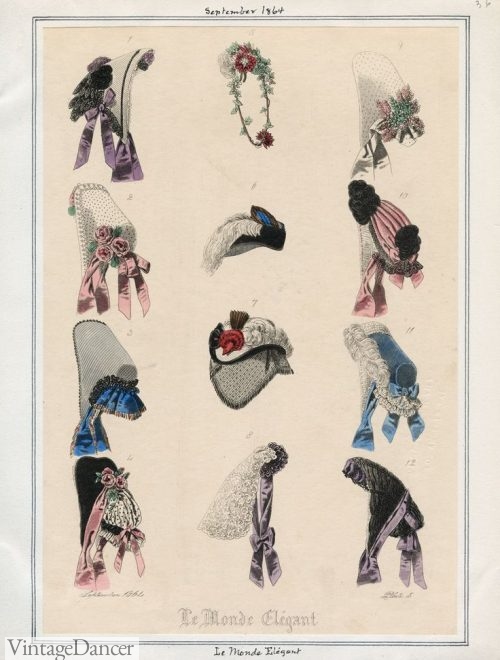
1864 hats and bonnets
Many bonnets of the 1860s are difficult to distinguish from dress caps of the same time. In 1863, the high raised forepart flattened, the crown grew smaller, and the sides, which were already receding, disappeared; at the same fourth dimension the drape grew smaller and then as well disappeared.
By the mid-1860s, the bonnet was no more than than a low-cal beat out of horsehair or crepe, high on the back of the head—"no longer bonnets but plaques of lace trimmed with the tiniest of flowers" (Ladies' Treasury, 1866).
These very small-scale bonnets continued in fashion until 1870, when the fashion journals were all the same making the same comment: "no such matter as a bonnet is now in being, and what is then called is a mere ornamentation for the caput—a puff, a diadem, a lace fluting, a bonnet of flowers, a band of ribbon" (Englishwoman'due south Domestic Magazine, 1870).
The changing styles of hat and bonnet during the 1860s were closely linked with the irresolute fashion in hairdressing. During the 1860s, the chignon increased in size and rose from a position low at the back of the caput in the first half of the decade to a mass of hair high at the dorsum of the head past the end of it, a modify which makes information technology articulate that the bonnet of the early 1860s could no longer exist worn in the belatedly 1860s.
The strings of the minor flat bonnets were often tied at the back beneath this high chignon. Roughly speaking, the size of the bonnet in the late 1860s was in inverse proportion to the quantity of hair, whether existent or added, displayed in the hairdressing. The raising of the hairdressing at the back of the head meant that, from 1867, hats were worn tilted frontwards over the brow: the small bonnets rested flat at the top of the head or made a narrow diadem of crepe or lace with flowers or ribbon at the front end of the head. Shop Victorian hair accessories, wigs and pieces.
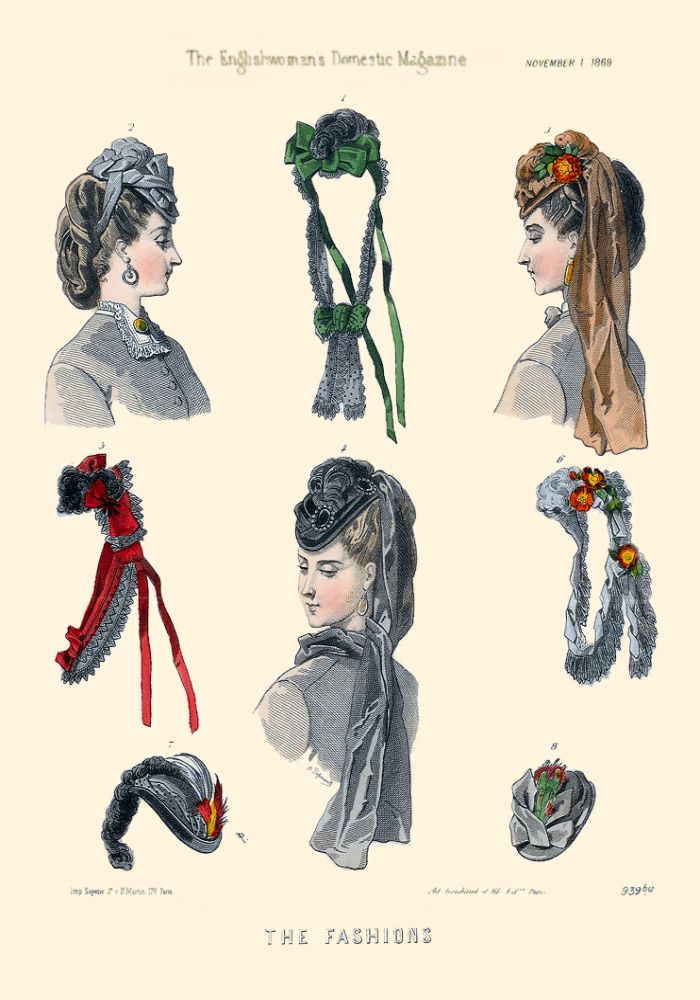
1869 hats and headdresses
Mid Victorian Hats -1870s, 1880s
From 1871, the hairdressing became looser, merely still more than complicated and elaborate, usually needing much additional hair. High-crowned hats, with turned-up brims, continued to be worn, tilted over the forehead, and these were perhaps the almost popular form of the early 1870s.
From 1872 a new form appeared. This was a lid similar a male child'due south sailor hat of the time, with a circular crown, and brim turned upwards all around. It was much worn and remained fashionable until 1875. "The round marin anglais hat with sloped- upwards skirt all circular which ladies wear pushed over chignons … is certainly the most absurd way . . . withal it is a great favorite with ladies of almost all ages. These chapeaus are exactly the same shape as our lilliputian boys' felt hats . . . only they are ornamented with feathers and aigrettes and tied with broad strings of grosgrain or moire ribbon" (Englishwoman'south Domestic Magazine, 1875).
From 1872, and more than mostly from 1873, the high chignon was worn inside the crowns of hats and bonnets, then that the forward tilt changed to a backward tilt for bonnets, and hats rested high on top of the head. The round brimmed hat was besides worn in a bonnet class, the only difference being the strings which tied the bonnet nether the chin. And then even this slight distinction was lost for a few years in the mid-1870s, when bonnets were worn without strings. The flat bonnets of the 1860s had disappeared, just the diadem form, without crown merely profusely trimmed with flowers, remained.
From 1874, the upturned brims of the crewman bonnet were trimmed with flowers. A bonnet with a round crown, like this, but with a diadem course in front, was some other manner of the mid-1870s. By 1877, wide strings which tied in a bow under the chin once again appeared on the bonnet.
The bonnet with diadem brim remained popular and another form—normally called the Directoire—which has the brim lowered so that information technology lies flat, close to but non touching the caput, was also popular.
Past the end of the decade, bonnets resembling hats had given place to a more definite bonnet grade; the brim disappeared from the back and broad strings were once more tied beneath the chin.
The loftier-crowned hat disappeared in the mid-1870s, although versions of this grade with lower, less sharply defined crowns were yet existence worn until the end of the decade. A new hat form for the second half of the 1870s was one with a larger crown and a medium brim which turned up at the back. A toque shape with a fairly high crown also became stylish from 1877, and was worn resting high on the head. From 1878, a circular crowned chapeau with wide skirt turned up at one side, known as the Gainsborough, was worn and continued as a popular fashion into the 1880s.
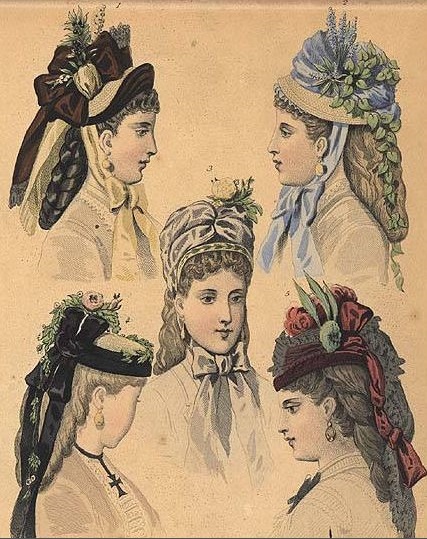
1875 hats
Hats of the 1870s were more elaborately trimmed than hats of the 1860s. In the early years of the decade, both bonnets and hats were oftentimes trimmed with ribbons at the back, which hung over the chignon, in addition to other trimming. These disappeared in 1875.
After 1874, bonnets showed an increasing apply of flowers in their trimming. "Simple field blossoms are the most fashionable this summer," said the Englishwoman'due south Domestic Magazine in 1875, but nearly any kind of flowers may exist found on them. The same journal commented in the following year that drooping foliage was worn, "a pleasant relief from the stiffness of the bonnets worn two years ago with high skirt and formal flowers".
1880s Hats
In the second half of the 1870s, and in the 1880s, whole birds as well as parts of birds were used for the trimming of bonnets. Feathers were much used in the millinery of the 1880s, non only as trimmings simply also as the fabric of the whole hat, particularly in the toque forms. Plush, a favorite fabric of the 1880s, was also much used for winter millinery, as information technology was for dresses, muffs and bags.
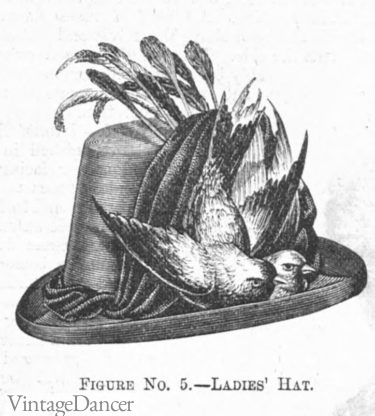
1886 ii whole birds adorn this hat
The earlier materials, velvet, felt, straw, all continued in apply; just silk was non much used, apart from the light crepe of the much- trimmed clothes bonnets. Lace was used as part of the fabric of the lighter bonnets, mingled with flowers and feathers. Beaver appeared once again from 1887.
Straw hats and bonnets were much worn throughout the 1880s, when they lost their seasonal connection and appeared amongst winter as well as summer fashions. "Throughout the yr, straw is the one material that never goes out and vast numbers of straw bonnets are fabricated with rows of velvet alternate with the straw" (Woman's Earth, 1888).
The coarser straw plaits were fashionable and fancy harbinger plaits in openwork patterns appeared over again in the 1880s, just the openwork plaits of this period are heavier and less lace-like than the before openwork plaits of the 1850s.
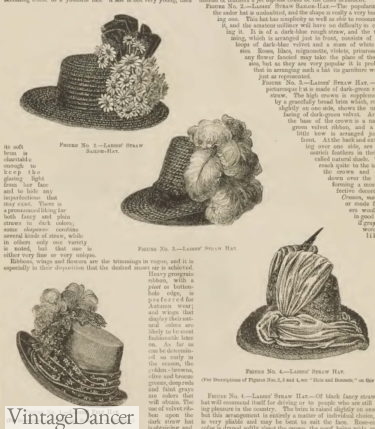
1886 harbinger hats (left hat lower corner)
The large hat with one side turned upwards, the Gainsborough, remained fashionable for near the whole of the 1880s. From 1884, a new way of chapeau appeared, which was especially characteristic of the 1880s, although the fashion journals insisted at first that it was a style suitable only to very young faces. This was the postilion or postal service-boy hat, with high crown like a flowerpot, and narrow brim.
Hats with this shaping of the crown were fashionable between 1884 and 1888. Some had a fairly narrow skirt turned up at one side; some had the brim turned up at the back and direct in the front, a style chosen Directoire although it bore niggling resemblance to the bonnet which had been given that name a few years earlier; on others, the brim was turned back at each side. The loftier crown also appeared in the toque, with a wide banded brim.
In 1888, "The hats which are distinctively new have brims that widen in front and more than closely resemble the crewman shape than any other. Some of these brims plow upward like an inverted saucer" (Woman's World, 1888). This style of chapeau with the brim jutting out over the face was a characteristic manner of the years from 1888 to 1892.
Hats of the crewman shape, either with a high crown and a broad apartment brim or with a flatter crown and medium skirt, were "worn by the meg" in 1887. Severely plain versions of this shape, in stiffened harbinger with a ribbon band, were worn for yachting and lawn tennis and, by 1890, hats in this way had become generally worn, not only for all summertime sports merely with the plainer and more than practical styles of everyday apparel.
In bonnets the fashion of 1880 continued until 1884. During the mid-1880s, bonnet crowns too grew college, though less noticeable than those of hats. Brims frequently made a pointed shape over the brow from 1887. A manner for bonnets without strings, which came again in 1888, makes information technology difficult to distinguish betwixt a bonnet and a toque of this date. The toque was a manner for younger women, who also wore the very small-scale bonnets without crowns which were once again stylish by 1888.
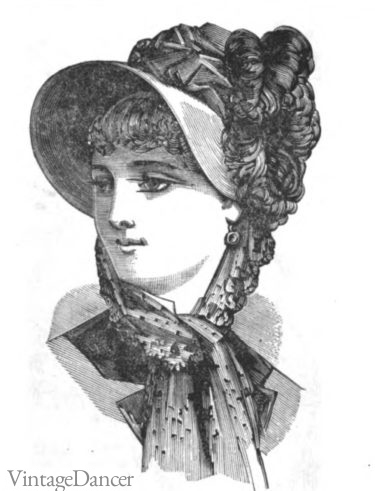
1882 bonnet
Particularly feature of the bonnets of the early 1880s was the edging of the bonnet brim with beads. The strings of the bonnets at this fourth dimension were wide. Ribbons, feathers and flowers were all used as trimmings. In 1888 it was said that "nothing in flowers is a la mode unless it looks as if it had merely been gathered in the garden and tied up loosely", and that "fashionable hats all resemble walking gardens" (Woman's Earth, 1888).
Lace was oft used to trim harbinger bonnets and hats, besides as beingness used with plush and velvet. The brims of straw bonnets and hats of this decade were often lined with velvet and hats of the late 1880s sometimes had trimming below the brim. For hats of more informal vesture, silk scarves were used as trimming, loosely knotted effectually the crown. The system of the trimming is a distinguishing marking of hats and bonnets of the second half of the decade.
By 1890, the bonnets were very pocket-sized, ofttimes almost non-existent, or hidden beneath their trimmings of bows or ribbon, flowers, feathers and lace. The departure between a bonnet and toque of this time was marked just by the strings of the bonnet, now narrow—an inch wide or less—and fixed well at the back. By the finish of the century, the bonnet with strings had become a middle-aged manner.
Larn how to make an 1880s bustle era hat with this online class from Historical Sewing
Late Victorian 1890s Hats
The hats of the 1890s show great multifariousness of shape and size. Subsequently 1892 the hat with the skirt jutting widely over the face in front end went out of mode. Wide-brimmed hats were notwithstanding worn, with the brim turned up sometimes at 1 side, sometimes at both sides, and then that the under brim was visible. From the mid-1890s, these wide-brimmed hats were worn placed slightly sideways.
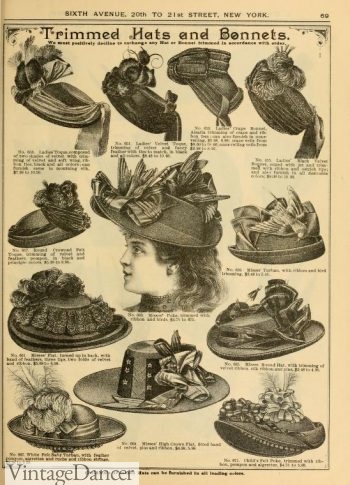
1890 mixed shape hats
The yet popular sailor shapes, with flat crowns and straight brims of medium width, were worn straight on the head. Witch- crowned hats, that is, hats with crowns pointed in a cone-shape, were stylish in the mid-1890s.
A crown chosen "yeoman", which widened at the top, was fashionable in 1896, and another very characteristic crown of this year was the hr-drinking glass crown. The boat-shape, with brim turned up at the sides, still remained a popular fashion, particularly fabricated in felt as a walking or cycling lid.
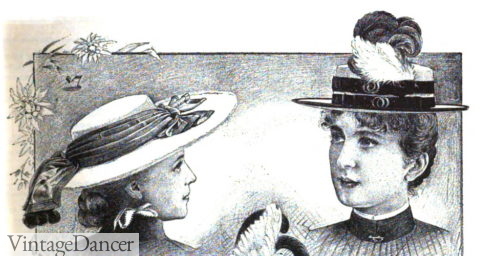
1890 boater hats
In 1896 a high-crowned version of this style with the crown cloven, a little like a man's trilby chapeau, came into fashion. A cloven-crowned hat with apartment brim was besides worn. Hats with wide brims upturned in front end appeared in 1898. If the brim was not upturned, it now often had a curving tilted line from left to right, or was curved upwardly on each side from the eye.
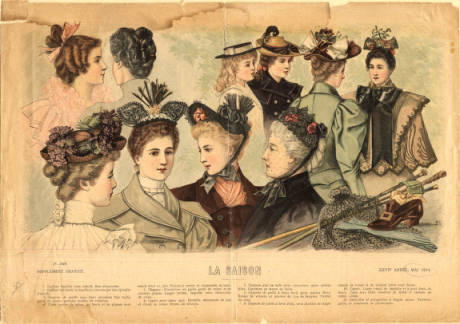
1894 hats and hairstyles
Toques with high crowns were worn in the mid-1890s, and iii-pointed or four-pointed toques were besides a fashion of these years. By the concluding years of the century, the toque was larger, with a soft, full crown, and often with a wide turned-back skirt and high trimming.
The openwork straws which had been fashionable in the 1880s continued to exist worn in the 1890s. Harbinger, bit, velvet and felt were the chief materials used for hats and bonnets but, for the lighter summertime millinery, net, chiffon and lace were often used. Flowers were still used in large quantities for trimming: "Hats continue to await like blossom-gardens" (Woman at Home, 1896).
Violets were peculiarly fashionable in 1890, and bunches of currants were another favourite trimming of this year. Throughout the decade there was a fashion for a single loftier ornament in the trimming, an aigrette of lace or ribbon, a high cock's feather, or one or two ostrich plumes.
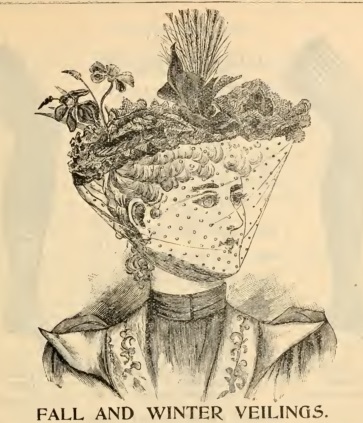
1895 veil lid
Bonnet Veils Bonnet veils were worn in part as a protection against sun and clay, in part as an added elegance for the bonnet and head. Those worn in the 1830s were particularly decorative. Many examples of them survive, simply they are not always recognized as bonnet veils. They are big, for wearing with the wide-brimmed bonnets, most a one thousand square, though unremarkably not an exact foursquare; along one side there is a hem to take a drawstring of narrow silk ribbon, and the other sides accept a bordering design.
They are, understandably, ofttimes mistaken for aprons. They were made in blonde lace, in auto-made internet with embroidered patterns, or in figured silk gauze. Frequently the footing was patterned within the border. They were white, foam, stake pinkish or mauve, but during the 1830s there was a very large proportion of blackness veils.
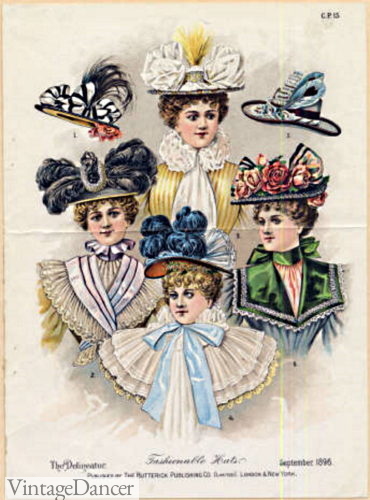
1886 hats
Obviously night blue and green gauze veils were also regarded every bit suitable for country wearable, when protection from the sun rather than decoration was the main concern. Large veils were worn until the mid-1840s, just they then became nearly one-half their former size.
By 1860, a semicircular bonnet veil was the usual course, merely large plenty to reach the mentum, and black was once again popular. Veils were less worn with the hats of the 1870s and 1880s, simply they became more fashionable and larger in the 1890s. The veils of this period were usually clear internet, with pocket-size spot patterns.
"Uglies" Another, less decorative, protection from the sun, was used in the 1840s and 1850s. This was a narrow shade, four half-hoops of cane, with silk, ordinarily blue, gathered over them so that it folded into a single half-hoop. It was worn on the front of the bonnet, the two ends tying together beneath the chin. It was known as an "ugly" and was seen mainly at the seaside, where it made an amusing miniature of the hoods which were attached to bathing machines to conceal the bathers' entry into the water.
Proceed reading about 1900-1910s hats.
Victorian Hat Resources
Hat shapes- make basic Victorian lid shapes with these patterns
How to alter manifestly harbinger hats into Victorian-era shapes
Make a bonnet from a straw hat
0 Response to "1885 and 1895 Women Middle Class Summer Fashion"
Post a Comment